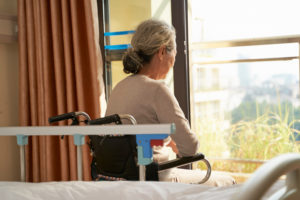What Is a Sacral Pressure Ulcer?
BedsoresA sacral pressure ulcer, also known as a decubitus ulcer or bedsore, is a condition that occurs when too much pressure and friction occur on the skin, creating an open wound.
Care providers must carefully treat these painful and infection-prone pressure ulcers to minimize the risk of worsening, as they can become life-threatening.
If you or your family member suffered sacral pressure ulcers due to a hospital or nursing home stay, speaking to a nursing home injury attorney about your rights to compensation is critical. In many situations, these sores develop due to negligence in a person’s care.
What Is a Bedsore?
People often refer to sacral pressure ulcers simply as bedsores. Decubitus ulcers actively form over the top of a bony body area. They can occur anywhere on the body but tend to be where the skin and bone are closest.
About 75 percent of this particular type of bedsore occurs around the pelvic girdle, including right on the back and buttocks where the tailbone extends. They can also happen on the ankles and heels of the feet.
When a pressure sore like this develops, it is typically the result of prolonged pressure on the skin in the same location. That pressure cuts off the blood flow to the cells in the area.
Within a short period, the skin becomes damaged due to the lack of proper blood flow, and the skin tissues begin to break down and die. This creates wounds at the point of the pressure spot.
Over time, this can worsen, with the wounds getting larger by spreading outward and deeper, moving further into the body’s tissues.
Bedsores can develop quickly. Some begin developing in only hours once a person cannot move. Other times, they can take several days to develop. The speed of their development often depends on factors such as the individual’s overall health, mobility, and the quality of care provided.
Regular repositioning, proper nutrition, and diligent monitoring are essential to prevent and promptly address the formation of bedsores, ensuring the well-being of individuals with limited mobility.
While bedsores are not always a sign of nursing home neglect, they often are. Discuss a loved one’s bedsore with a nursing home lawyer to determine your options.
Why Do Sacral Pressure Ulcers Develop?
 The development of bedsores occurs for multiple reasons, typically because a person has remained in one position for too long, limiting the amount of blood flow to that area.
The development of bedsores occurs for multiple reasons, typically because a person has remained in one position for too long, limiting the amount of blood flow to that area.
This can happen if:
- A patient remains in a hospital bed without moving for hours at a time.
- A person sits in a chair for long hours without moving.
- Nursing home staff do not transfer a patient out of a wheelchair for an extended period.
When a person cannot change their position on their own due to disability or mobility issues or because that person is unconscious or otherwise cannot move, the duty of turning and moving the patient falls on the nurses and medical team present. If this does not happen, a person may not receive the level and type of care they need. In a healthcare setting, one can view this as negligence.
Are Bedsores Preventable?
A person with a sacral pressure ulcer is likely to be suffering from significant pain. There are some situations where a person may be prone to developing this type of condition, especially if they have underlying conditions like diabetes that make skin damage more likely.
However, due to the way they occur, bedsores are typically preventable by not allowing a person to remain in one position with pressure on a specific area for too many hours at a time.
A person who is ill, paralyzed, very weak, or unconscious cannot move on their own. That means any area where their skin is touching something else, like the bed, is where pressure develops and skin breaks down. By reducing this friction and preventing the pressure, getting relief from the onset of pressure sores is possible.
There is no doubt this is challenging. Caregivers or healthcare professionals must move a person who cannot move. Those who have limited mobility need help. However, there are methods available that can reduce these risks when used.
Implementing regular repositioning schedules, utilizing pressure-relieving devices such as special mattresses or cushions, and ensuring proper skincare can significantly mitigate the risk of bedsores.
Caregivers and healthcare providers play a crucial role in implementing these preventive measures to enhance the comfort and well-being of individuals with limited mobility, minimizing the challenges associated with developing bedsores.
Using air mattresses
An air mattress is one of the most effective ways to reduce the risk of patient bedsores. Designers create these mattresses with tiny holes distributed across the surface. Those holes help to create a very small amount of detachment between the skin and the surface of the mattress, eliminating the pressure that causes bedsores.
More so, they alternate pressure spots, allowing for relief from one area to the next as a person remains still. This helps to avoid the pressure altogether.
Many times, air mattresses are not comfortable. Patients or nurses may turn them off (they require a constant air flow to keep them moving and operating properly). If they are not operating, they cannot help the person.
Other types of aids
Other aids may also help reduce the risk of bedsores developing. For example, there are also foam mattresses designed for this task. They are softer and disperse more of the pressure a person experiences over a larger area.
This helps to minimize the pressure on specific at-risk areas, like the tailbone. They are not always easy to use, and some people may not prefer sleeping on them.
Another option is a sheepskin mattress cover. Though many people do not like how they feel because they heat up, there is some evidence they can help reduce the development of bedsores specifically.
To alleviate pressure from high-risk areas, use specially designed pillows to elevate the heel, support the hips at the tailbone, and provide cushioning under a person’s feet.
Why Did Your Family Member Develop a Sacral Pressure Ulcer?
 It is not uncommon for doctors and nurses to use words like sacral pressure ulcers because they sound complex and rare. Bedsore brings up a lot of liability risk. That is because it is very common for people in nursing homes and long-term care facilities to suffer from bedsores due to negligence. When a nursing home is negligent, a nursing home lawyer can hold the facility accountable for you.
It is not uncommon for doctors and nurses to use words like sacral pressure ulcers because they sound complex and rare. Bedsore brings up a lot of liability risk. That is because it is very common for people in nursing homes and long-term care facilities to suffer from bedsores due to negligence. When a nursing home is negligent, a nursing home lawyer can hold the facility accountable for you.
Here are some of the most common reasons this happens in these settings:
Limited mobility
Anyone who cannot easily move on their own is at risk for developing bedsores. Even if a person seems okay laying in bed, the pressure remains, especially on their tailbone. Sacral ulcers are often the main type of damage to the skin that occurs in people who are bedbound.
Also, note that a person who can transfer from a bed to a wheelchair or chair is still at risk. They are still experiencing a significant amount of sedentary lifestyle. This increases the risk of bedsores developing, though even a slight change in position can offer some relief.
Excessive moisture presence
Another factor contributing to the development and worsening of these types of pressure ulcers is the presence of moisture. A person who is in bed all of the time cannot move, will sweat, and develop moisture in the pelvic region of their body. Coupled with the risk is the difficulty that many bedbound people face in accessing a bathroom easily, leading to accidents occurring in the bed.
This moisture, along with the heat that’s pressure in this area, can create a high level of bacteria development due to the humidity created. This moisture also further irritates the skin, causing damage to the surface quickly and leading to a higher risk of infection development.
Lack of communication
A person who cannot communicate is particularly vulnerable to developing bedsores. If they cannot communicate that they need to switch positions or that they have irritation on their skin, moisture buildup, or pain, that condition remains present, worsening over time.
A common situation here occurs in people who can move but cannot communicate. They may have physical or mental blocks that make it hard to communicate what is occurring to them. Other times, a lack of ability to communicate due to the repercussions of strokes can also cause this lack of communication.
You should always note that it’s not always easy for many seniors in nursing homes to ask for help. As a result, they may not ask to get up and move around, saying they are okay where they are. Yet, this can lead to the development of painful skin irritations. Sometimes, if there is ample nerve damage, a person may not even realize how bad the sores are.
Lack of nutrient-rich diet
A diet lacking sufficient nutrients and dehydration actively contribute to developing skin damage and pressure sores. When a person does not get enough moisture, the skin is one of the first areas the body pulls that moisture from to meet its needs. Dry skin is more likely to suffer intense damage.
A diet lacking protein, vitamins, and minerals is a risk factor for bedsore development. Your body needs those nutrients to constantly repair skin cells. Without it, the damage cannot happen.
When Is a Sacral Pressure Ulcer Negligence?
Bedsores can worsen over time, and as they do, they become highly risky to the health and well-being of the patient. Many times, this is due specifically to negligence.
It may be negligent if:
- The healthcare facility owed the patient a level of confidence that they could be safe, which is easily assumed here.
- The location did not provide a safe space or the care expected.
- That breach of duty in providing quality care leads to the development of the bedsores.
- The bedsores required medical care and led to pain and suffering or other losses.
Nursing homes and hospitals recognize the risks of bedsores. This is a known problem within the healthcare system, so healthcare providers should address it routinely on a preventative level.
What can a hospital or nursing home do to reduce the risk of bedsores developing?
- Moving patients: Routine care and supervision greatly reduce these risks. By helping to move a patient on a schedule, they can potentially reduce the risk of bedsores developing.
- Use of supportive devices: The investment and use of air or foam mattresses can also help. These are typically available for healthcare settings but may require expensive upgrades.
- Proper staffing: Ensuring proper staffing is also important. If a person cannot get the help they need to move easily or get to the bathroom in time, this can also increase the risk of these ulcers.
- Recognition of complications: Patients who have trouble communicating or sensing pain may need additional support and oversight to ensure they receive care and movement frequently.
- Proper nutrition: Ensuring patients receive proper nutrition and hydration is also important. This can help to minimize the development of these conditions.
- Skin checks: While this does not prevent them, it can prevent the worsening of conditions because it allows for early intervention. Skin checks should be a routine process within these healthcare settings.
Failure to provide this care can lead to holding the nursing home or medical facility accountable for the individual’s losses. Unfortunately, this is not uncommon – The U.S. Centers for Disease Control and Prevention shares that between two and 28 percent of nursing home residents have a pressure ulcer like this.
Contact a Nursing Home Injury Lawyer if Your Family Member Is Suffering
Your first step is getting your family members the necessary medical care. Significant bedsores can require hospitalization and advanced medical care. Following that, promptly contact your attorney for legal guidance and initiate the necessary steps to seek compensation and address any negligence or abuse concerns.
A personal injury attorney can assist in determining what happened and why these injuries developed. This can aid in determining if there is any necessary and advisable legal action. In many situations, victims are owed financial compensation for the pain and suffering, medical bills, and other losses they suffer as a result of injuries like this. Seek immediate care and support from a nursing home neglect attorney who can guide you.
Nathan Hughey, an attorney and fourth-generation South Carolinian, founded Hughey Law Firm in 2007. Before that, he spent five years defending nursing homes and insurance companies. Leveraging his experience, he now advocates for those injured or wronged by such entities, securing over $220 million in verdicts and settlements.
